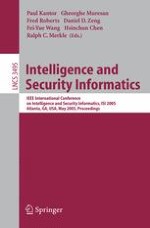Intelligence and security informatics (ISI) can be broadly defined as the study of the development and use of advanced information technologies and systems for national and international security-related applications, through an integrated technological, organizational, and policy-based approach. In the past few years, ISI research has experienced tremendous growth and attracted substantial interest from academic researchers in related fields as well as practitioners from both government agencies and industry. The first two meetings (ISI 2003 and ISI 2004) in the ISI symposium and conference series were held in Tucson, Arizona, in 2003 and 2004, respectively. They provided a stimulating intellectual forum for discussion among previously disparate communities: academic researchers in information technologies, computer science, public policy, and social studies; local, state, and federal law enforcement and intelligence experts; and information technology industry consultants and practitioners. Building on the momentum of these ISI meetings and with sponsorship by the IEEE, we held the IEEE International Conference on Intelligence and Security Informatics (ISI 2005) in May 2005 in Atlanta, Georgia. In addition to the established and emerging ISI research topics covered at past ISI meetings, ISI 2005 included a new track on Terrorism Informatics, which is a new stream of terrorism research leveraging the latest advances in social science methodologies, and information technologies and tools. ISI 2005 was jointly hosted by Rutgers, the State University of New Jersey; the University of Arizona (UA); and the Georgia Institute of Technology (GATECH).
